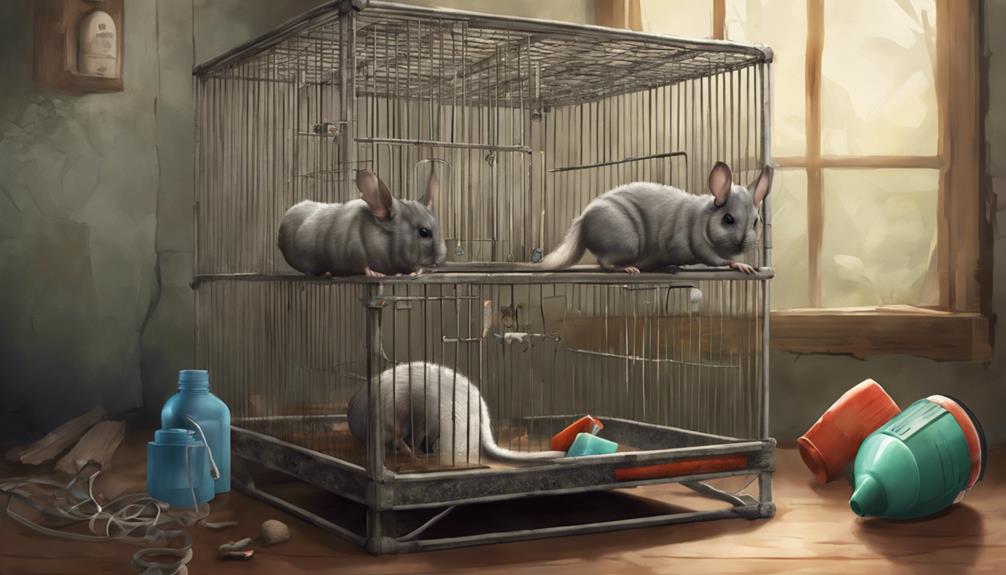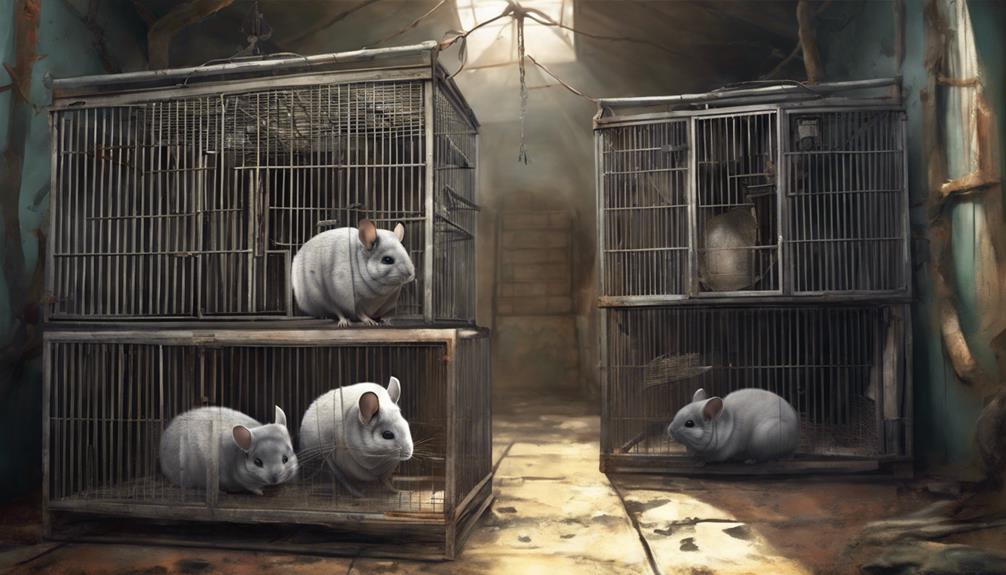What to Do If Your Chinchilla Escapes: Secure Habitat Tips

If your chinchilla escapes, stay calm and don't panic.
First, secure any door or window that may have been left open.
Next, set out some of your chinchilla's favorite treats in a quiet area where it may be hiding.
Check small spaces or dark corners where your chinchilla could be hiding.
Consider setting up a live trap with some enticing food inside.
If your chinchilla is still missing, ask neighbors to keep an eye out and check nearby bushes or shrubs.
Lastly, contact local animal shelters and post flyers in the area to increase the chances of finding your beloved pet.
Remember, patience and persistence are key when trying to locate a lost chinchilla.
Key Takeaways
- Regularly inspect and secure the habitat to prevent escapes.
- Implement trapping techniques with strategic bait placement.
- Enhance habitat security with sturdy materials and locks.
- Seek professional guidance for tailored advice and security measures.
Assessing the Escape Situation
How can you determine if your chinchilla's habitat is secure enough to prevent any potential escape attempts?
Evaluating risks and implementing escape prevention measures are vital steps in making sure your chinchilla remains safe and secure in its environment.
Begin by carefully examining the habitat for any potential weak points such as loose cage doors, gaps in the fencing, or areas where your chinchilla could chew through to escape. Regularly check the integrity of the habitat to address any issues promptly.
Make sure that the cage is made of sturdy materials that can withstand the chinchilla's chewing habits. Secure all openings with locks or clips to prevent accidental escape.
Consider placing barriers around the habitat to create an additional layer of security. By being proactive and thorough in evaluating the risks and implementing escape prevention strategies, you can provide your chinchilla with a safe and secure environment where it can thrive and enjoy its freedom.
Searching in Safe Areas
When searching for a chinchilla in safe areas, it's crucial to check all potential hiding spots carefully.
Placing bait strategically can entice the chinchilla to come out of its hiding place.
Remember to stay calm and patient during the search to avoid startling the chinchilla further.
Check Hiding Spots
Inspect the hiding spots in your chinchilla's habitat to guarantee they are secure and safe for your furry friend. Check crevices and monitor surroundings diligently to make sure your chinchilla has not found a way to hide or escape. It's important to maintain a calm demeanor while searching, as sudden movements can startle your pet. To help you in this process, here is a table to guide you on where to look for your chinchilla:
| Common Hiding Spots | Secure and Safe Areas |
|---|---|
| Behind furniture | Inside the cage |
| Underneath cabinets | In a designated play area |
| Inside closets | Closed-off rooms |
| Behind curtains | Underneath supervised blankets |
Use Bait Strategically
Strategically placing bait in secure areas can be an effective method to entice your chinchilla out of hiding for observation and guarantee their safety. When using strategic baiting for escape prevention, make sure you choose enticing treats like raisins or dried fruits that your chinchilla loves.
Place these treats in areas where your chinchilla is likely to pass by, such as near their hideout or favorite spots. Remember to monitor the bait closely and check it periodically to see if it has been touched.
Stay Calm and Patient
Remaining composed and patient while searching in safe areas is essential to ensuring a successful reunion with your chinchilla. It's crucial to approach the situation calmly to prevent scaring your pet further.
Here are some tips to help you during the search:
- Search methodically: Check every nook and cranny, starting closest to where the chinchilla escaped.
- Use treats: Entice your chinchilla with their favorite treats to coax them out of hiding.
- Stay quiet: Avoid loud noises or sudden movements that may startle your chinchilla, causing them to retreat further.
- Block off hiding spots: Close off any potential hiding spots to limit the areas your chinchilla can access.
- Stay patient: Remember, chinchillas are naturally cautious, so it might take some time for them to feel safe enough to come out.
Setting Traps With Caution
When setting traps for chinchillas, it's important to place them in safe locations to prevent harm.
Luring chinchillas with treats can help attract them to the traps effectively.
Remember to monitor the traps regularly to guarantee the safety and well-being of your chinchilla.
Safe Trap Placement
Positioning traps in chinchilla habitats requires careful consideration to make sure the safety of both the chinchilla and any other pets in the area. When setting traps, always remember the following:
- Choose safe locations: Place traps away from areas where other pets or children frequent.
- Avoid narrow spaces: Ensure traps are positioned in open areas to prevent entrapment.
- Secure traps properly: Double-check that traps are stable and won't cause harm.
- Consider visibility: Opt for visible trap placement to easily locate captured chinchillas.
- Regularly check traps: Monitor traps frequently to swiftly release any trapped chinchillas.
Lure With Treats
To effectively lure chinchillas into traps, consider enticing them with their favorite treats placed strategically within the trap. Treat training can be a powerful tool in this situation, as chinchillas are naturally drawn to their favorite snacks. When setting traps, it is crucial to use luring techniques that appeal to the chinchilla's senses and instincts. Below is a table with examples of treats that are commonly irresistible to chinchillas:
| Treats | Examples |
|---|---|
| Dried Apple Slices | Small pieces |
| Rose Hips | Natural and aromatic |
| Timothy Hay Cubes | Crunchy and flavorful |
| Blueberries | Sweet and juicy |
| Raisins | Chewy and sweet |
Monitor Traps Regularly
Regularly monitoring traps is important to guarantee the safety and well-being of your chinchilla. When setting traps, it's essential to make sure they're checked and maintained regularly. Here are some tips to keep in mind:
- Inspect traps daily: Check for any signs of activity or if the trap has been triggered.
- Adjust trap placement: Move traps to different locations if no activity is seen in a particular area.
- Use surveillance techniques: Consider setting up cameras to monitor trap activity remotely.
- Keep traps clean: Regularly clean traps to remove any lingering scents that may deter your chinchilla.
- Check for any damages: Make sure traps are in good condition and repair any damages promptly to maintain their effectiveness.
Using Tempting Lures Strategically
Strategically placing enticing treats can help encourage your chinchilla to explore and engage with its habitat. By placing tempting treats in various parts of the enclosure, you can entice your furry friend to move around and investigate different areas. Consider placing treats near hiding spots, perches, or toys to encourage your chinchilla to interact with its environment.
When guaranteeing placing tempting treats, guarantee they're securely positioned to prevent them from rolling away or getting lost in bedding material. You want your chinchilla to easily spot and access the treats without difficulties. This method not only promotes mental stimulation but also encourages physical activity, keeping your chinchilla active and happy.
Remember to rotate the placement of treats regularly to maintain your chinchilla's interest and prevent them from becoming bored with their surroundings. By using tempting treats strategically, you can create a dynamic and engaging habitat that encourages exploration and play for your chinchilla.
Securing Potential Escape Routes

Guarantee all potential escape routes in your chinchilla's habitat are securely blocked to prevent any accidental exits. Evaluating vulnerabilities and taking proactive steps can help make sure your chinchilla stays safe and secure.
Here are some essential tips to prevent escapes:
- Check Cage Latches: Regularly inspect cage latches to make sure they're secure and functioning correctly.
- Cover Small Openings: Block any small gaps or holes in the cage where a chinchilla could potentially squeeze through.
- Secure Doors and Windows: Keep doors and windows in the room where the chinchilla is housed closed to prevent unexpected escapes.
- Eliminate Clutter: Remove any objects near the cage that a chinchilla could use to climb and potentially escape.
- Supervise Playtime: When allowing your chinchilla out for playtime, closely monitor their movements to prevent any escape attempts.
Enhancing Habitat Security Measures
To further strengthen your chinchilla's habitat, consider implementing additional security measures that bolster protection and peace of mind. Habitat modifications play a vital role in preventing escapes and guaranteeing your chinchilla's safety.
Start by checking for any gaps or openings in the cage where your chinchilla could potentially squeeze through. Secure these areas by adding mesh or wire barriers to prevent any escape attempts. Additionally, consider reinforcing the cage corners and edges to ensure sturdiness and prevent any weak points that could be exploited.
Another important aspect of enhancing habitat security is to regularly inspect the cage for wear and tear. Replace any damaged parts promptly to maintain the structural integrity of the habitat. Investing in a high-quality lock for the cage door can also provide an extra layer of security and prevent accidental openings.
Seeking Professional Help and Advice

Consider consulting with a professional for expert guidance on optimizing your chinchilla's habitat security. Seeking help from experienced individuals can provide valuable insights and solutions to guarantee your chinchilla's safety and well-being. Here are some reasons why seeking professional guidance is beneficial:
- Tailored Advice: Professionals can offer customized advice based on your chinchilla's specific needs.
- Preventive Measures: They can help you implement preventive measures to avoid potential escape situations.
- Behavioral Insights: Professionals can provide insights into chinchilla behavior that can enhance habitat security.
- Emergency Response Plans: They can assist in creating effective plans in case your chinchilla escapes.
- Resource Recommendations: Professionals can recommend the best resources and tools to secure your chinchilla's habitat effectively.
Frequently Asked Questions
Can Chinchillas Be Trained to Come Back When Called if They Escape?
Chinchillas can be trained to come back when called if they escape. Consistent recall training builds trust with your pet. Implement escape prevention measures like secure habitats to minimize the chances of runaway adventures.
How Long Can a Chinchilla Survive Outside of Its Habitat if It Escapes?
Chinchillas have strong survival instincts and can hide in various spots. When escaping, they may seek shelter for days. Predators pose a threat, so swift action is essential. Chinchillas should be kept safe indoors.
Are There Any Specific Scents or Sounds That Can Help Attract a Chinchilla Back if It Escapes?
Chinchillas can be enticed back with familiar scents like vanilla or apple, and the sound of rustling treats can pique their curiosity. Training with recall techniques, such as using a clicker, can help reinforce returning behavior.
What Should I Do if My Chinchilla Escapes During Extreme Weather Conditions?
During extreme weather conditions, it's important to act swiftly if a chinchilla escapes. Utilize capture techniques like offering treats or creating sheltered areas outside. Guarantee habitat security beforehand to prevent escapes. Swift action is key.
Are There Any GPS Tracking Devices Available for Chinchillas to Prevent Escapes in the Future?
Chinchilla owners can explore microchip implantation or indoor playpen options for added security. These measures offer peace of mind and help prevent escapes. By considering these solutions, chinchilla owners can guarantee their pets' safety and well-being.











